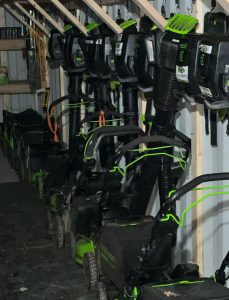Maintaining a lush and vibrant lawn in British Columbia requires more than regular care during the growing season. As winter approaches, it’s crucial for gardeners and landscapers to properly prepare and store their lawn equipment to ensure its longevity and peak performance come spring. In this comprehensive guide, we’ll explore various types of lawn equipment, including lawnmowers and trimmers, and provide detailed instructions on winter storage tailored to the unique conditions in British Columbia.

I. Lawnmowers:
Types of Lawnmowers:
- Gas-Powered Mowers:
- Popular for larger lawns.
- Drain or run the fuel tank dry to prevent stale fuel issues during storage.
- Remove and clean the spark plug.
- Sharpen the blade for a clean cut next season.
2. Electric Mowers:
- Environmentally friendly and easy to maintain.
- Store in a dry place to prevent electrical components from rusting.
- Remove the battery and store it indoors in a cool, dry place.
3. Manual Reel Mowers:
- Great for smaller lawns.
- Clean blades thoroughly and apply a light coat of oil to prevent rust.
- Store in a dry location to avoid moisture damage.
II. Trimmers and Edgers:
Gas and Electric Trimmers:
- Gas Trimmers:
- Run the trimmer until it’s out of fuel, or use a fuel stabilizer.
- Clean debris and inspect for any loose parts.
- Store in a cool, dry place.
2. Electric Trimmers:
- Clean the cutting head and check the power cord for any damage.
- Store in a dry area, ensuring the cord is neatly coiled.
III. Winter Storage:
Preparing for Winter Storage:
- Clean Thoroughly:
- Remove grass clippings, dirt, and debris from all equipment.
- Use a wire brush to clean the blades.
2. Inspect for Damage:
- Check for any wear and tear on belts, cables, and moving parts.
- Replace or repair damaged components.
3. Oil and Lubricate:
- Apply a thin coat of oil to metal parts to prevent rust.
- Lubricate moving parts to ensure smooth operation next season.
- Selecting Storage Locations:
4. Dry and Cool:
- Choose a dry, cool place for storage to prevent moisture damage.
- Avoid areas prone to extreme temperature fluctuations.
5. Secure and Covered:
- Store equipment in a secure shed or garage to avoid theft.
- Cover equipment to protect it from dust and debris.
IV. Regional Considerations for BC:
- Moisture Control:
- Use moisture-absorbing products in storage areas to prevent rust.
- Consider placing equipment on pallets to elevate them from the ground.
2. Extreme Cold Precautions:
- For gas-powered equipment, use a fuel stabilizer to prevent fuel line issues.
- Store batteries indoors to prevent cold-related damage.
Conclusion:
Proper care and storage of lawn equipment are essential for ensuring a healthy and beautiful lawn in British Columbia. By following these guidelines, gardeners and landscapers can extend the life of their equipment and be ready for the next growing season. Whether you have a small lawn or a sprawling landscape, a little effort in winterizing your equipment goes a long way in maintaining a well-groomed outdoor space in the diverse climate of British Columbia.

